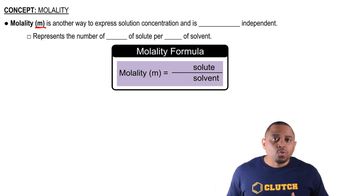Here are the essential concepts you must grasp in order to answer the question correctly.
Boiling Point Elevation
Boiling point elevation is a colligative property that describes how the boiling point of a solvent increases when a solute is dissolved in it. This phenomenon occurs because the presence of solute particles disrupts the formation of vapor above the liquid, requiring a higher temperature to reach the boiling point. The change in boiling point can be calculated using the formula ΔT_b = i * K_b * m, where ΔT_b is the boiling point elevation, i is the van 't Hoff factor, K_b is the ebullioscopic constant of the solvent, and m is the molality of the solution.
Recommended video:
Molality
Molality (m) is a measure of the concentration of a solute in a solution, defined as the number of moles of solute per kilogram of solvent. It is an important concept in colligative properties because it directly influences the extent of boiling point elevation. To calculate molality, one must first determine the number of moles of solute and then divide by the mass of the solvent in kilograms, providing a way to quantify the effect of solute on the solvent's properties.
Recommended video:
Ebullioscopic Constant (K_b)
The ebullioscopic constant (K_b) is a property of a solvent that indicates how much the boiling point of the solvent will increase per mole of solute added. Each solvent has a unique K_b value, which is used in the boiling point elevation formula. For ethyl alcohol, this constant is essential for calculating the normal boiling point when given the boiling point of a solution, allowing for the determination of the pure solvent's boiling point by reversing the elevation effect.
Recommended video:




